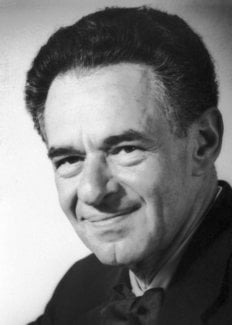Fritz Lipmann
Biographical

Fritz Albert Lipmann was born on June 12th, 1899, at Koenigsberg, Germany. He was the son of Leopold Lipmann and his wife Gertrud Lachmanski.
Lipmann was educated, during the years 1917-1922, at the Universities of Koenigsberg, Berlin, and Munich, where he studied medicine. He took his M.D. degree in 1924 at Berlin. He was, during his pre-clinical year of medical study, strongly impressed by what he has called «a dramatic chemistry course» given by Professor Klinger at Koenigsberg. Later, he took a primer course in biochemistry given in Berlin by Professor Rona and in 1923 he definitely took up biochemistry, and held for a time a Fellowship in the Department of Pharmacology, at the University of Amsterdam, under Professor Ernst Laqueur. Feeling then the need for further study of chemistry, Lipmann returned to Koenigsberg to study chemistry under Professor Hans Meerwein, who had then succeeded Professor Klinger. In 1926 he went as an assistant in Otto Meyerhof‘s laboratory at the Kaiser Wilhelm Institute, Berlin, to prepare a thesis for the degree of Ph.D., Berlin, which he took in 1927. He then went with Meyerhof to Heidelberg, where he did further research on the biochemical reactions occurring in muscle.
In 1930 Lipmann went back to the Kaiser Wilhelm Institute in Berlin to work as a research assistant in the laboratory of Albert Fischer, who was interested in applying biochemical methods to tissue culture. Fischer was then getting ready to occupy a new Institute in Copenhagen and he asked Lipmann to accompany him there, which he did in 1932. The years 1931 and 1932, however, he spent as a Rockefeller Fellow in the laboratory of P. A. Levene at the Rockefeller Institute in New York, where he identified serine phosphate as the constituent of phosphoproteins which contains the phosphate.
When he went to Copenhagen in 1932, as Research Associate in the Biological Institute of the Carlsberg Foundation there, Lipmann became interested in the metabolism of fibroblasts and this prompted him to investigate the Pasteur effect, which led to important papers on the mechanism of this reaction and on the part played by glycolysis in the metabolism of the cells of embryos.
In 1939 Lipmann became Research Associate in the Department of Biochemistry, Cornell Medical School, New York, and in 1941 joined the research staff of the Massachusetts General Hospital in Boston, first as a Research Associate in the Department of Surgery, then heading his own group in the Biochemical Research Laboratory of the Hospital. In 1949 he became Professor of Biological Chemistry at Harvard Medical School, Boston. In 1957, he was appointed a Member and Professor of the Rockefeller Institute, New York, a post which he still holds.
During the late forties and early fifties, the wealth of problems opened up by the discovery of coenzyme A attracted much attention. He left this post to explore the chemical nature of some seemingly unusual phosphate derivatives arising in the process of group activation through phosphoryl transfer from ATP. Thus, through observations on a phosphorolysis of citrulline, his attention was drawn to the probability of carbamyl phosphate (CMP) representing the metabolically active carbamyl donor. The suspicion proved justified, and proof of metabolic formation and its function, in collaboration with Mary Ellen Jones and Leonard Spector, was greatly simplified by the latter’s discovery of an unexpectedly simple method of chemical CMP synthesis through condensation of cyanate and phosphate at room temperature and in excellent yield.
Another unusual phosphate derivative had been indicated through the function of ATP in sulphate activation. Work with Hilz and Robbins in this area brought out the existence of a new class of chemical compounds, the mixed anhydrides between phosphate and sulphate; adenosine-5′-phosphosulphate (APS) and 3′-phosphoadenosine-5′-phosphosulphate (PAPS) were identified as «active» sulphates. The latter compound, PAPS, was found in animals and plants to be the common sulphate donor in the sulphurylation of mono- or poly-saccharides and other sulphate derivatives.
Recently, most of his attention has returned to development of the biological mechanism of peptide and protein synthesis. At present, this is what has become his major interest.
Lipmann is a member of several learned societies in the U.S.A., the Faraday Society, and the Danish Royal Academy of Sciences and is a Foreign Member of the Royal Society of England. He holds honorary degrees of the Universities of Marseilles, Chicago and Chile, and is Doctor of Humane Letters of Brandeis University. In 1931, he married Elfreda M. Hall, and they have one son, Steven.
This autobiography/biography was written at the time of the award and first published in the book series Les Prix Nobel. It was later edited and republished in Nobel Lectures. To cite this document, always state the source as shown above.
Fritz Lipmann died on July 24, 1986.
Nobel Prizes and laureates
Six prizes were awarded for achievements that have conferred the greatest benefit to humankind. The 14 laureates' work and discoveries range from quantum tunnelling to promoting democratic rights.
See them all presented here.
